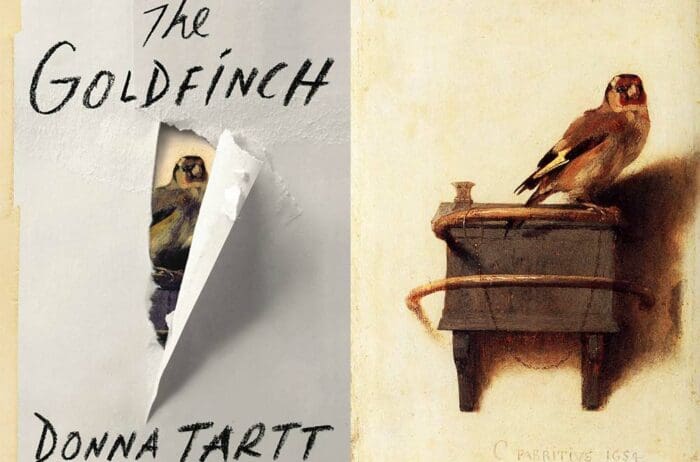 Since Donna Tartt’s debut, in which she was introduced to the world in an 8-page interview in Vanity Fair, she has amassed a cult of devotees. I am such a devotee. I loved The Secret History and especially loved The Little Friend. (It’s a mystery to me why The Little Friend is not as highly regarded as Donna Tartt’s other two novels, when I believe it’s the superior work.)
Since Donna Tartt’s debut, in which she was introduced to the world in an 8-page interview in Vanity Fair, she has amassed a cult of devotees. I am such a devotee. I loved The Secret History and especially loved The Little Friend. (It’s a mystery to me why The Little Friend is not as highly regarded as Donna Tartt’s other two novels, when I believe it’s the superior work.)
And now I’ve read The Goldfinch. The novel is extremely popular—beyond any current standard. Since it first arrived on bookshelves in the fall of 2013, the novel has sold millions of copies, earned a Pulitzer Prize, and sizzled in the zeitgeist. On Goodreads, I count 12 friends who have already read and rated The Goldfinch. The book has 517,102 ratings in total (as of the date of writing). It is a popular book. And what’s even more intriguing—it’s a popular work of literary fiction.
Vanity Fair has noted that opinions vary on the literary merit of The Goldfinch. The most high-brow of literary critics believe that the novel is riddled with clichés, is pretentious, and consists of Dickensian imitations. They deplore its lack of genuine emotional gravity, its implausible plot points and its overwrought conclusion. The New Yorker even likened it to children’s literature.
And I agree. Despite how thoroughly The Goldfinch entertained me, I found many parts of it infuriating. I was sucked into the story but exasperated by its frequent digressions (by ‘digressions’ I refer to the many details only some of which actually pay off). Tartt is a master at creating a compelling narrative engine—one that often begins with a dark, violent scene, the mystery of which will be unravelled over the course of the novel. In The Secret History, the protagonist has just committed murder. In The Little Friend, a nine-year-old boy is found hanging on Mother’s Day. In The Goldfinch, the mystery is two-fold: Theo Decker, our protagonist, is first holed up in an Amsterdam hotel, ostensibly avoiding capture for some crime, and then, 14 years earlier, he’s at the scene of a terrorist attack in a museum. Over the course of each of those novels, the narrative journey toward each of those scenes is developed.
Tartt is also gifted at creating a sense of place. From the visual details to the social tension, each scene of Tartt’s novels is excessively textured. After locking up a valuable object, Theo emerges from the storage building like this:
“Walking out of the building, its vautlike hush and the stale breezelet humming from the air vents, I felt giddy, unblinkered, and the blue sky and trumpeting sunlight, familiar morning exhaust haze and the call and cry of car horns all seemed to stretch down the avenue into a larger, better scheme of things: a sunny realm of crowds and luck.”
This style is both delicious for its accuracy and realness and indulgent for the way it may often be superfluous to the narrative. And, as the critics would say, when employing clichés like the “cry of car horns”, a tad unsophisticated. Because undoubtedly, in packing (or rather multiplying) her novel with this level detail, she employs quite a few clichés. And because we’re all captivated by the story, this style merely serves to distract.
What’s more, lest we stray too far from the narrative propulsion of the novel, Tartt makes sure that we sprinkle in good dose of exposition to remind of us the psychological turmoil of our protagonist. Later on in the same scene, Theo discovers that the building he has grown up was acquired by new owners. He reflects:
“It was weird to think I’d never be able t thank Jose and Goldie for the money they’d given me—or, even weirder, that I’d never be able to tell them my father had died: because who else did I know who had known him?”
While it’s unfair to criticize Tartt too harshly for these minor flaws—as most literary works are highly indulgent and some exposition is entirely necessary to fashion a narrative—the thing is, most literary works don’t rely on such a melodramatic premise to attract readers. In the New Yorker, James Wood lamented that Tartt didn’t just allow Theo to have his mother die in a more conventional way. That novel (one about a young boy’s dislocation and forced habitation with a reluctant parent) would be enough. The nonsense with the painting adds a narrative layer, and a highly implausible one, that detracts from any of the more authentic passages in the novel.
And one more thing- Tartt ends her novel with the most irksome of corny of reflections on the purpose of life and the value of beautiful things in creating purpose. I was so bored in those last few pages, I took a whole day to read 10 of them.
Essentially, I think Tartt’s novels are popular fiction dressed up with some ornate diction and appealing sensory detail. That doesn’t mean I wouldn’t recommend any of her previous novels- I loved them all and would read them again. I just agree that they aren’t really any innovation in the literary canon the way that Jennifer Egan’s or Zadie Smiths’ or Colm Toibin’s works are.
